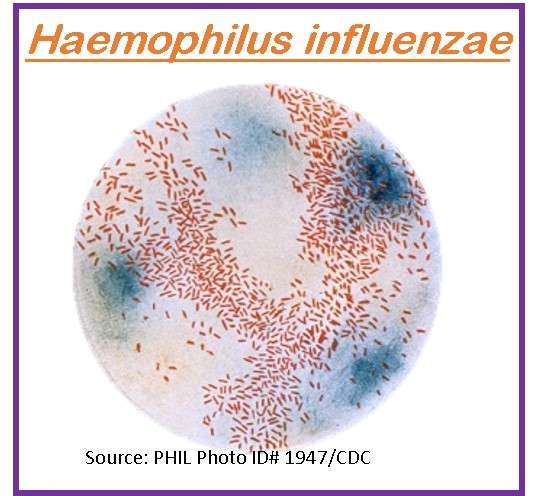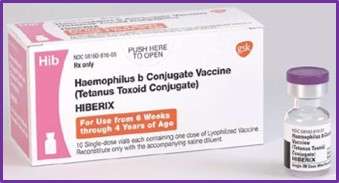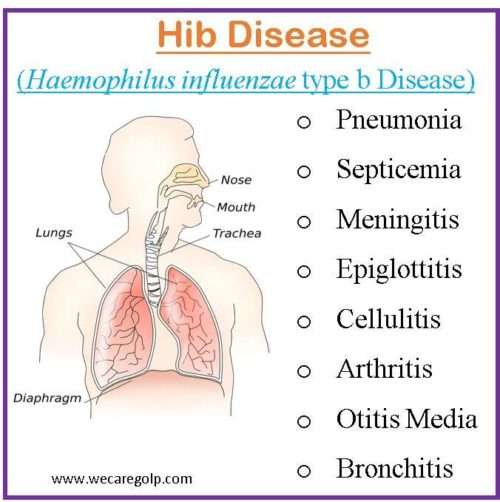Introduction
Hib (Haemophilus influenzae type b) disease is a contagious disease caused by the bacterium Haemophilus influenzae type b. Gram-negative Haemophilus influenzae bacteria can infect the respiratory tract and spread to other organs. Over 90% of systemic infections are caused by type b (Hib) of the six capsular H. influenzae types. It can affect the tissues under the skin, the lungs, the epiglottis at the back of the throat, the bones and joints, or the membranes around the brain (meningitis). It can also result in pneumonia.

- Hib illness can affect adults with specific medical conditions, although it is most common in infants and young children under the age of five.
- Hib is spread through prolonged contact with an infected individual as well as respiratory droplets, primarily through coughing and sneezing.
- The infection can result in either moderate illness; However, Hib meningitis can sometimes result in mortality, and problems include blindness, deafness, and learning difficulties.
- Immunization can protect against Hib infection.
- H. influenzae does not cause influenza (the flu), despite its name.
- H. influenzae is responsible for the most invasive diseases, which include
- Pneumonia (lung infection)
- Septicemia (bloodstream infection)
- Meningitis (swelling of the lining of the brain and spinal cord)
- Epiglottitis (swelling in the throat)
- Cellulitis (skin infection)
- Infectious arthritis (inflammation of the joint)
Incidence
- Before the introduction of a vaccine, each year, 1,000–20,000 children under the age of five suffered from severe Hib disease.
- The incidence of Hib infections has significantly decreased since the introduction of the vaccination.
- Since 1991, the number of instances of severe Hib disease has decreased by over 99%.
- The bulk of H. influenzae illnesses today in all age groups are caused by non-typeable H. influenzae.
- The rate was 1.62 per 100,000 children under the age of five in 2019. Today, children who are either under or not fully immunized account for most cases.
- The prevalence of non-typeable H. influenzae was 4.88 per 100,000 people aged 65 and above.
Incubation Period of Hib Disease
- The incubation period typically lasts between two and four days, but it might last longer.
Causes of Hib Disease
- The H. influenzae bacterium causes Haemophilus influenzae disease.
- These bacteria do not usually hurt people because they live in their noses and throat. However, the bacteria may occasionally spread to other parts of the body and cause infection.
Risk Factors of Hib Disease
Most cases of H. influenzae, including Hib disease, affect people 65 years of age or older and younger children under the age of five. Additionally, several medical disorders carry a higher risk. These health issues include:
- HIV infection
- Asplenia (lack of spleen)
- Sickle cell illness
- Cancer that needs to be treated with chemo, radiation, or a bone marrow stem cell transplant
- Young individuals, especially guys
- Black people
- Native Americans
- Individuals who attend or work at daycare facilities
- People with compromised immune system
Mode of Transmission of Hib Disease
- People can contract Haemophilus influenzae type b through respiratory droplets from coughs and sneezes.
- Even if the other person is asymptomatic and only has the germs in their nose or throat, the bacterium can still spread through prolonged or intimate contact.
- Aspiration of amniotic fluid or contact with genital tract secretions containing the bacteria can infect newborns.
Signs and Symptoms of Hib Disease
Various kinds of illnesses can be brought on by H. influenzae. The affected bodily portion determines the symptoms.
Pneumonia
- Sweating
- Chest pain
- Headache
- Muscle pain
- Excessive weariness
- Shortness of breath or trouble breathing
Septicemia
- Fever and chills
- Excessive weariness
- Belly pain
- Nausea with or without vomiting
- Diarrhea
- Anxiety
- Shortness of breath or trouble breathing
- Alteration in mental status (confusion)
Meningitis
- Fever
- Headache
- Stiff neck
- Nausea with or without vomiting
- Photophobia (eyes more sensitive to light)
- Alteration in mental status (confusion)
Babies with meningitis may exhibit the following symptoms:
- Irritability
- Vomiting
- Poor feeding
- Slowness or inactivity
- Abnormal reflexes
- Irritability
Epiglottitis
- Swelling of the epiglottis
- Difficulty breathing
- Fever
- Pallor
- Swallowing issues
- Dribbling and extreme agitation in babies
Arthritis
- Pain, tenderness, and swelling of the joint
- Fever
- Decrease range of motion
- Inflammation, and discomfort across the affected joints
Cellulitis
- Red, hot, swollen, and sensitive skin
- An infection of the tissue beneath the skin
Pathophysiology of Hib Disease
- Direct touch or respiratory tract droplet inhalation are the two main methods of transmission.
- Nasopharyngeal colonization of encapsulated H influenzae is rare, occurring in 2–5% of kids before widespread immunization and even less subsequently.
- The presence of concurrent viral infection or a higher bacterial load can aggravate the infection.
- The colonizing bacteria invade the mucosa and get into the bloodstream.
- The amount of bacteremia that is cleared depends on the presence of phagocytes, complements, and antibodies.
- Because the Hib capsule is antiphagocytic and the anti-capsular antibody is absent, bacterial growth is accelerated.
- It can spread to several locations, including the meninges, subcutaneous tissue, joints, pleura, pericardium, and lungs when the bacterial concentration exceeds a critical level.
Diagnosis of Hib Disease
Culture of blood or other body fluid sample
- Sample of pus, blood, or another bodily fluid to culture the bacteria to determine the infection.
Lumbar puncture
- A lumbar puncture on patients who exhibit meningitis symptoms to collect a sample of the cerebrospinal fluid, which surrounds the brain and spinal cord.
- The diagnosis is confirmed when the bacteria in a sample are identified.
Treatment/Management of Hib Disease
Treatment for H. influenza varies depending on the illness or type of infection. Antibiotics are frequently used during treatment to combat the illness. People with H. influenzae sickness may require hospitalization, depending on the severity of the infection.
Antibiotics
- When children are hospitalized with serious infections, they are placed in respiratory isolation for 24 hours after antibiotics are started. It is critical to start treating meningitis right away.
- An intravenous dose of an antibiotic is administered typically
- Ceftriaxone
- Cefotaxime
- Cefuroxime
- Different antibiotics are used to treat other H. influenzae infections. They include
- Azithromycin
- Cephalosporins
- Fluoroquinolones
- Omadacycline
- Lefamulin
- Clarithromycin
- Amoxicillin
- Clavulanate
Other treatment options
- Breathing assistance provided by intubation or a face mask with oxygen
- Infusions of steroids to lessen the risk of brain injury
- Antihypertensive drugs used to treat hypotension
- Wound care for areas of the body where the skin is damaged.
- Surgical drainage for arthritic septic shock.
- Doctors may prescribe antibiotics to treat milder infections caused by H. influenzae, such as bronchitis or ear infections, to avoid complications.
Complications of Hib Disease
- Loss of limbs due to bloodstream infections
- Brain damage or permanent hearing loss due to meningitis
- Seizures
- Learning disabilities
- Death
Prevention of Hib Disease
Vaccination
- Immunization is the main method of preventing Hib disease. The Hib vaccine, on the other hand, does not protect against diseases caused by other strains of H. influenzae.
- At 2 months of age, children should start receiving vaccinations.
- At 6 weeks of age, the vaccination may be administered to those who are at high risk for Hib illness.
- The recommended dose of the Hib vaccination is 0.5 mL intramuscularly (IM).
- Depending on the formulation, a primary childhood series is administered in 3 doses or 2 doses.

- In either scenario, a booster should be given between 12 and 15 months of age. At least eight weeks after the most recent Hib vaccination, administer the booster dose.
- Older children, teenagers, and adults with asplenia or who are scheduled for an elective splenectomy should receive one dose if they have not had the vaccine.
- Between 6 and 12 months after hematopoietic stem cell transplantation, a 3-dose regimen is administered; each dosage is spaced by around 4 weeks.
- Hib vaccine is recommended to someone who already has had Hib disease because a previous infection might not prevent you from recurrence infection.

Maintain a clean personal hygiene
- Practice frequent hand washing, particularly before touching the mouth, nose, or eyes; after touching shared objects like handrails or doorknobs; or when the hands are contaminated with respiratory secretions.
- Using liquid soap and water, scrub your hands for at least 20 seconds. Next, rinse with water before using a hand dryer or a disposable paper towel to dry.
- Cover your nose and mouth with tissue during sniffling or coughing.
- Wear a surgical mask, stay away from crowded areas, and get medical help right away if you feel sick.
- Avoid sharing eating and drinking utensils, and make sure to wash them well after each use.
- Reduce contact between young children who are contagious and other kids.
Maintain a clean environment
- Use household bleach mixed 1:99 (1 part 5.25% bleach to 99 parts water) to regularly clean and disinfect frequently touched surfaces, including furniture, toys, and shared items.
- Let the bleach sit for 15 to 30 minutes, then rinse with water and pat dry.
- Use 70% alcohol to disinfect metallic surfaces.
- To remove visible contaminants, such as respiratory secretions, use disposable absorbent towels.
Prognosis
- A favorable outcome can be ensured by meningitis treatment and early detection.
- The prognosis also depends on the age at presentation and the level of capsular polysaccharide in bodily fluids.
- When compared to complex or invasive Hib illnesses, the prognosis for uncomplicated Hib pneumonia and nonencapsulated H. influenzae pneumonia is often better.
- The overall fatality rate from Hib meningitis is about 5%. However, meningitis has a significant morbidity rate.
- Up to 50% of people with Hib meningitis may experience some neurologic sequelae if subtle neurologic abnormalities are considered.
- Roughly 6% of people with Hib meningitis may develop persistent sensorineural hearing loss.
- Neonatal H. influenzae illness has a mortality rate of 55%, while epiglottitis has a mortality rate of 5–10% (due to acute respiratory tract blockage).
Summary
- Hib disease is a contagious disease caused by the bacterium Haemophilus influenza type b.
- Children under the age of five and individuals with impaired immune systems are most typically affected by H. influenzae type b (Hib) sickness.
- Sneezing, coughing, or touching can spread an infection.
- In addition to respiratory infections, the bacteria can also cause middle ear infections, sinusitis, and more severe illnesses like meningitis and epiglottitis.
- The diagnosis is confirmed by identifying the bacteria in a sample of blood or affected tissue.
- Children receive a vaccine that effectively shields them from H. influenzae type b infections regularly.
- Antibiotics are used to treat infections, either orally or intravenously in the case of severe illnesses.
References
- Khattak, ZE., Anjum, F. (2023, Jan). Haemophilus Influenzae. StatPearls Publishing. Retrieved on 2023, April 24 from https://www.ncbi.nlm.nih.gov/books/NBK562176/
- Hong, E., Terrade, A., Denizon, M., Aouiti-Trabelsi, M., Falguières, M., Taha, M. K., & Deghmane, A. E. (2021). Haemophilus influenzae type b (Hib) seroprevalence in France: impact of vaccination schedules. BMC infectious diseases, 21(1), 715. https://doi.org/10.1186/s12879-021-06440-w
- Janet R Gilsdorf, (2021, Oct 1). Hib Vaccines: Their Impact on Haemophilus influenzae Type b Disease, The Journal of Infectious Diseases, 224, S321–S330, https://doi.org/10.1093/infdis/jiaa537
- Brundage, HL., Mukka, SK., (2023, Jan). Haemophilus Influenza Type B Vaccine. StatPearls Publishing. Retrieved on 2023, April 22 from https://www.ncbi.nlm.nih.gov/books/NBK553112/
- Gilsdorf J. R. (2021). Hib Vaccines: Their Impact on Haemophilus influenzae Type b Disease. The Journal of infectious diseases, 224(12 Suppl 2), S321–S330. https://doi.org/10.1093/infdis/jiaa537
- Center for Diseases Control and Prevention (2022, March 4). Haemophilus influenza diseases (including Hib). Retrieved on 2023, April 23 from https://www.cdc.gov/hi-disease/index.html.

